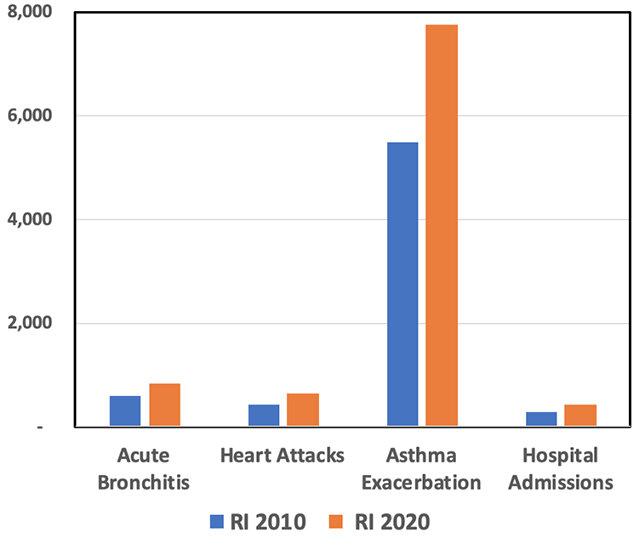Clean Air Act Annually Saves R.I. $6.5 Billion and 740 Lives
January 8, 2020
Late last month I explained the savings for the entire United States from the reduction in pollution that resulted from the implementation of the Clean Air Act more than five decades ago. This story examines the savings that migrate down to Rhode Island and its population.
The Environmental Protection Agency (EPA) has estimated that the annual dollar value of benefits from the Clean Air Act is now at some $2 trillion. These massive savings are directly attributable to air quality improvements, and they will continue to grow over time as emissions-control programs take their full effect.
To help make the following comparisons more understandable, all dollar amounts below are in billions.
The 1963 law’s investment costs, which were significant, amounted to $65 billion and were distributed across several industrial sectors. Much of this upfront cost ($28 billion) was invested in vehicles and fuel.
However, the dollar benefits, which this year are estimated to be almost two thousand billion, are vastly greater than the $65 billion in investment costs.
This can be put into context as follows. Suppose the $65 billion in costs were invested in S&P stocks, which over the period 1990 through 2020 returned an average of 6.6 percent. After 30 years, this $65 billion investment would return $204 billion, more than three times the original investment.
The return from the Clean Air Act, however, is 30 times the investment costs and more than nine times the return from investing the same amount in S&P stocks.
But what does this mean for Rhode Island?

In 2018, the Rhode Island population was 1,057,315, which was 0.32 percent of the U.S. population of 327.2 million. Therefore, for the Ocean State, the proportional savings from the Clean Air Act are about $6.5 billion annually, or some $6,000 for every person in the state.
The governor’s fiscal 2020 budget is $9.9 billion, so the $6.5 billion in savings from the Clean Air Act represents 65 percent of the entire state budget.
Using the same population proportion, we can estimate the reduction in the number of deaths for Rhode Islanders from lowered particulate matter and lowered ozone concentration.
Over 30 years, the gradual increase in deaths avoided amounts to a total of more than 11,000 Rhode Island lives saved by the Clean Air Act. There are 12 towns in the state with populations less than 11,000.
Additional cost benefits from the Clean Air Act are attributable to the decrease in medical treatment expenditures, which the law refers to as “avoided medical costs.” This tends to understate the value of detrimental health impacts because it doesn’t include the additional benefits that individuals experience from improved health.
If the Clean Air Act hadn’t been in effect, in Rhode Island this year, there would be 7,700 more serious asthma events, 820 more bronchitis attacks, 640 more heart attacks, and 430 more hospital admissions.
It’s thought-provoking to estimate the potential impact of these events on a local hospital. Last August, Newport Hospital celebrated the expansion and renovation of its emergency department. The $12.5 million project doubled the number of treatment rooms and gives Newport Hospital the capacity to serve more than 40,000 patients annually.
What might have happened to Newport Hospital had the Clean Air Act not been in effect? Newport Hospital serves Aquidneck Island, which represents about 6 percent of the Rhode Island population. Therefore, 6 percent of “avoided health events” represents about 9,000 patients.
In 2018, the Newport Hospital emergency department treated 33,000 patients. Without the Clean Air Act, an additional 9,000 patients would have visited, for a total of 42,000.
Since Newport Hospital’s new facility is planned to support 40,000 patients annually, without the Clean Air Act, it would already be too small. In fact, Newport Hospital would have had to have built a larger ER in 2016 and would now be looking at another, much larger expansion.
The Clean Air Act and its amendments have saved billions of dollars in Rhode Island and saved tens of thousands of lives. However, as the Newport Hospital example shows, the benefits of the Clean Air Act go well beyond the costs and lives saved.
Roger Warburton, Ph.D., is a Newport, R.I., resident.




True.